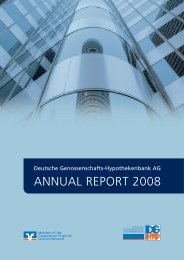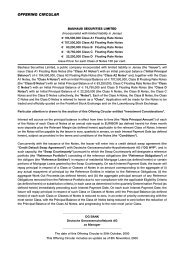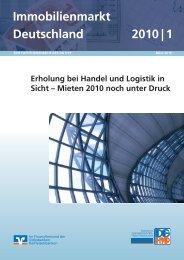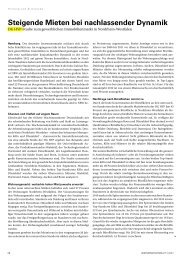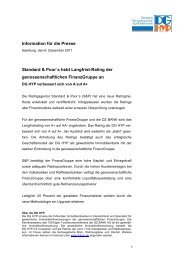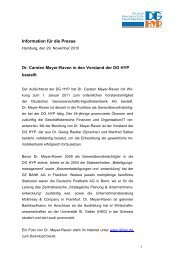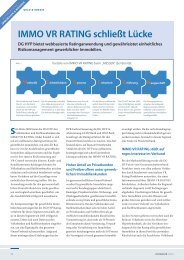Covered Bonds - DG Hyp
Covered Bonds - DG Hyp
Covered Bonds - DG Hyp
You also want an ePaper? Increase the reach of your titles
YUMPU automatically turns print PDFs into web optimized ePapers that Google loves.
<strong>DG</strong> HYP COVERED BONDS – PFANDBRIEFE – QUALITY THE PATH OUT OF THE CRISIS SPECIAL MAY 2009<br />
In the medium to long term, analysis expense will be one of the key determinants of the<br />
spreads demanded by investors. Investors‘ trust in the rating agencies has been holed<br />
below the water-line, with the result that investors (or at least the biggest investors) are now<br />
using their own models to identify what they consider to be a fair value against swaps. As<br />
far as pfandbriefe are concerned, this analysis is likely to show that the quality of issuers’<br />
cover pools is as high as ever. The concerns they feel with regard to the issuers will then<br />
need to be related to what they know about the cover pools. This makes us confident that<br />
once the covered bond market recovers to any extent, pfandbrief swap spreads will be back<br />
below their current level again. Further widening cannot be ruled out in the meantime,<br />
however.<br />
�<br />
Banks as liquidity providers – Does market making have a future?<br />
In the past, functioning market making has always been an essential prerequisite of<br />
secondary-trading liquidity – especially as far as investors were concerned. This raises the<br />
question whether market making can be expected to resume at all, or whether it is<br />
alternatively conceivable that a degree of secondary-market liquidity might build up even in<br />
the absence of market making. For there is no doubt that with the end of market making, the<br />
pfandbrief market has also lost an important marketing tool.<br />
First things first, though: we do not expect any banks to materialise in the near or mediumterm<br />
future that will be willing to promise to quote binding bid and ask prices in anything like<br />
the way that was standard practice just eighteen months ago. In a worst-case scenario, this<br />
could result in them taking on positions, i.e. ending up with more holdings on their books, a<br />
thing that many banks wish to avoid at all costs. In any case, market making in its familiar<br />
form is no longer a viable alternative since the world has seen that it stops functioning in<br />
crisis situations – precisely when it is most urgently needed – and what is worse, even<br />
reinforces negative market trends.<br />
Banks in general will no longer be prepared in future to make their balance sheets available<br />
in order to supply liquidity to the market – and in specific cases, possibly even provide<br />
liquidity that mainly benefits other market participants with smaller balance sheets behind<br />
them. The decision to provide liquidity – or not – will be weighed up much more carefully in<br />
future, and should this course not provide the banks concerned with clear advantages, we<br />
expect most to decide no. We need to bear in mind that the very lack of transparency that<br />
prevails in illiquid markets will provide an opportunity for some banks to book much bigger<br />
benefits than they could in an efficiently functioning and highly liquid market.<br />
�<br />
Electronic trading systems possible routes out of illiquidity<br />
The realisation that market making can cease to function in times of crisis has led some<br />
market participants to consider how trading might be transferred onto a completely<br />
electronic platform. Liquidity arguments would not be the only benefits that mattered in this<br />
decision; actors see a good chance that the opportunity to boost transparency that this form<br />
of trading offers might help to overcome the market’s loss of trust.<br />
Various suggestions have now been put forward for how trading could be moved online.<br />
The ideas range from a daily auction of covered bonds (divided into different maturity<br />
bands), via the transfer of telephone trading onto an electronic system, through to a full<br />
electronic B2B trading system. Without wishing to go into the details too deeply, we see the<br />
routing of more trading onto an electronic system as the right way forward. Naturally, the<br />
scale of the switch needs to be discussed, as telephone trading does offer clear<br />
advantages. The important thing to bear in mind in our view is that something needs to be<br />
Spreads will tighten again long‐term<br />
Historically, an important marketing<br />
tool<br />
Avoiding increased holdings<br />
Balance sheets will no longer be<br />
made available<br />
Liquidity and enhanced<br />
transparency the goals<br />
Proposals range from auction<br />
through to B2B platforms<br />
6





